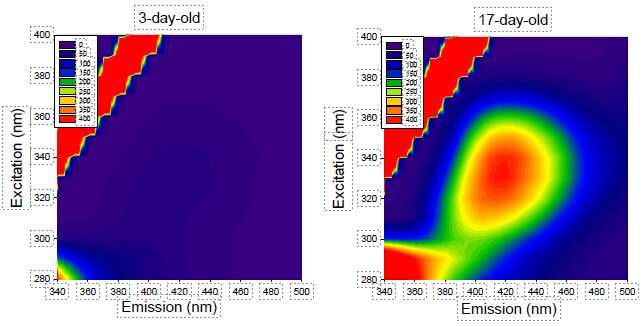
Professor Emeritus Yoshikazu Nishikawa of Osaka City University’s Graduate School of Human Life Science, and collaborators, have found that a substance that emits a specific fluorescence in vivo increases with age. The fluorescence is derived from advanced glycation end products (AGEs) and correlates with the life expectancy of C. elegans. The measurement technology of this model could be used for the search and evaluation of anti-glycation materials in the future.
The results of this research were published in the international academic journal npj Aging and Mechanisms of Disease on Monday, June 7, 2021.
As the global population ages and preventive measures against age-related diseases such as dementia and cancer become increasingly important, glycation in the body is attracting attention as an important risk factor for aging and lifestyle-related diseases. It is known that the amount of AGEs in the body increases with aging and age-related diseases such as diabetes and arteriosclerosis, and measuring the amount of AGEs in the body is expected to be an indicator for predicting aging and age-related diseases. However, experiments on natural aging using humans and mammals require several years, and AGEs detection methods are mainly invasive blood tests, which require expensive and special experimental operations using antibodies, such as ELISA. The relationship between glycation and aging in the body is still unclear and a simple method for evaluation has not yet been established.
This research group hypothesized that AGEs could be indirectly assessed by measuring the fluorescence of some AGEs, and succeeded in clarifying the relationship between AGEs and fluorescence in vivo using the model organism Caenorhabditis elegans, and in developing a high-throughput evaluation method.

In this study, the research team first conducted fluorescence spectrum analysis using protein extracts from young and old C. elegans and found that specific fluorescence was enhanced in protein extracts from old worms (Fig. 1). They developed a method to detect the fluorescence in vivo and following the same worm over time, they found that the fluorescence value increased with age. In addition, they found that fluorescence decreased in long-lived C. elegans mutants and in ones treated with rifampicin, which has an anti-glycation effect, the lifespan was extended, while fluorescence increased in C. elegans treated with ribose, which has a strong glycation effect. Furthermore, when protein extracts from young C. elegans, which did not fluoresce, were artificially glycated, they fluoresced at the same wavelength as old C. elegans, suggesting a strong relationship between this fluorescence, AGEs, and aging. As a result of comparison by analysis of all proteins expressed in old and young worms and observing this with fluorescence microscopy, the team found that this fluorescence was derived from AGEs-derived vitellogenin (Fig. 2).
This suggests that the fluorescence at specific wavelengths emitted from the body of the worm reflects AGEs, and by measuring this fluorescence, the amount of AGEs in the body can be estimated, suggesting the possibility of using it as an indicator of aging.
Source: Read Full Article